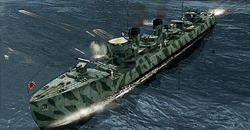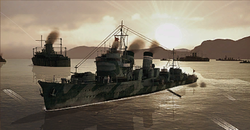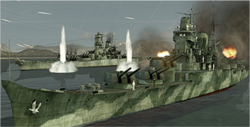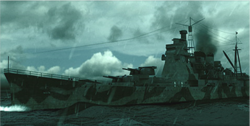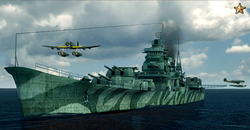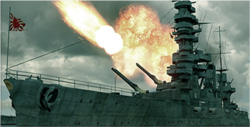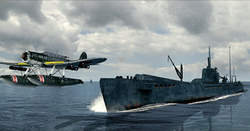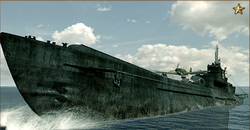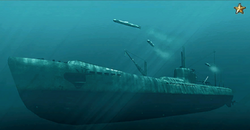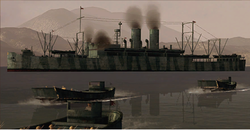Unlike the previous game, nearly all units are playable. The few that are not are units like the Daihatsu LCP. Considering the rarity of completely non-playable units, they are grouped in with the regular units.
The IJN ships have received some facelifts since the previous game, in particular the Minekaze-class and, to a lesser extent, the Kuma-class.
Gyoraitei
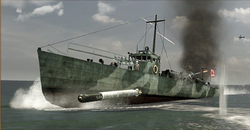 | |
| Armaments | AA Weapons: 25mm/60 Triple AA x2 Torpedoes: Torpedo tubes x4 Depth Charge: Depth charge rack |
|---|---|
| Class | PT |
| Speed | 47 knots |
| Strong against | Submarines, Cargo Ships |
| Weak against | Everything |
The Gyoraitei is the Japanese PT boat, and it has received a lot of love since Midway. The Japanese have apparently decided raw power was still the way to go with the Gyoraitei, but that going with the cannon wasn't worth it. Replacing the forward machine gun and the big cannon with two triple machine guns, the Gyoraitei now has a bigger fighting chance against other Elcos. The accuracy of these weapons isn't the greatest, however, and is most prevalent when it comes to attacking aircraft. As a result its effectiveness against aircraft is somewhat limited. Any competent pilot can handle a Gyoraitei easily.
Its other upgrade has been the addition of two torpedo tubes, bringing its effectiveness, again, closer to that of the Elco. The Gyoraitei also has a reasonable capture rate, and is good for sailing around in Island Capture maps to quickly capture bases. Considering its low command point cost, several of these can be sent around the map to quickly claim bases.
Official Description: The Japanese have a variety of small coastal vessels that provide a similar role to the US Elco PT boat. The Japanese versions are not as fast or manoeuvrable as the Elco, but they do mount two 25mm guns that packs a punch against lightly armoured surface targets. In addition they also mount machine guns, depth charges, and torpedoes, meaning they can pose a threat to any target.
Minekaze-class
The Minekaze, and its American counterpart, the Clemson, have both received some upgrades since Midway. Its primary armament has remained unchanged, but its cannons are now dual-purpose, to make it more effective against aircraft. Needless to say, however, there are other ships that are much better against aircraft, but the Minekaze's effectiveness as an escort has increased considerably.
Against other ships, it is grossly under-armed. It lacks the number of guns of neither the Fletcher nor the Fubuki. However, it still has its six torpedo tubes, arranged in three double-mounts, making it a threat to any ship in close range. Don't even bother using your smaller cannons against battleships. Instead, try to charge into a position to bring torpedoes to bear. This will, at the very least, draw some fire away from the larger warships, and give them a chance against your heavier opponent.
Official Description: These ships were among the first to be completely designed and built by the Japanese, who had previously been using foreign designs and manufacturers, Entering the IJN as "first-class destroyers", the Minekaze-class are considerably outdated now and have many shortcomings, including the small number of guns they carry, the fact they are open-mounted and have no armour protection, and very light AA armament. However, they do mount triple torpedo launchers, making them a dangerous proposition for any large ship.
Fubuki-class
The Fubuki-class destroyer remains virtually unchanged from Midway. Its speed, armour, and weapons remain remarkably similar from Midway. It is a common destroyer and superior to the Minekaze-class in all respects. Its guns are uniquely positioned in that there is only a single bow-mounted cannon and two at the back. This gives it a slight edge when running, especially from other destroyers.
Armed with dual-purpose guns, it is a potent anti-aircraft platform, although the new Akizuki-class destroyer gives it a run for its money. The Akizuki-class notably lacks significant torpedo armament, however, making the Fubuki a better ship when facing off against heavier enemies that would shrug off destroyer fire.
Official Description: The Fubuki-class was the first modern destroyer design. Entering service in 1928, her twin 5" mounts located in enclosed turrets and her triple torpedo launchers gave her firepower far greater firepower than any other ship of her size at the time. Since then, other destroyer designs have appeared that can match the Fubuki-class, most notably the American Fletcher-class. Nevertheless, these are still versatile and useful ships, and their dual-purpose 5" guns give them a potent defence against attacking aircraft.
Shimakaze-class
Your eyes do not deceive you - the Shimakaze-class destroyer has a whopping 15 torpedoes, arranged in three 5-mounts. This, naturally, gives them unparalleled attacking power on the waves, and can saturate an area with torpedoes with extreme ease. This, coupled with their speed (just 5 knots slower than a patrol boat) makes them extremely deadly when not spotted. Some players describe them as a "glass cannon" - capable of dishing out damage with 15 rapid-firing torpedoes, but unable to take damage being a destroyer. In fact, it seems to have a little less armour than the Fubuki-class. However, if you need a ship to deliver the coup de grâce against an enemy battleship, the Shimakaze-class will serve you perfectly. So long as another battleship is present to draw fire away from the vulnerable Shimakazes, the Shimakaze will sink practically any ship with a few well-placed torpedoes.
In terms of fighting other destroyers, its prowess isn't the greatest but it can still hold its own. Its artillery armament is identical to that of the Fubuki, although it seems to lack armour. In a destroyer-vs-destroyer fight, consider it a faster Fubuki-class and treat it as such. Be on the lookout, however, for a gigantic school of torpedoes heading your way. Use your destroyer's agility and small size to rush quickly on the Shimakaze whilst dodging its torpedoes.
Its high speed can also allow it to chase down submarines with ease. In terms of sub-hunting, its attacking power is no greater than that of a Fubuki, although submarine captains must be aware of the large number of torpedoes the Shimakaze has and should avoid at all costs surfacing near one's broadside.
Obtain a silver medal in Mission 9 - Solomons' Skirmish to unlock this swift torpedo destroyer.
Official Description: The Shimakaze was one of the largest and most powerful destroyers in the Japanese arsenal. In addition to its heavy weaponry and large number of torpedoes, the ship had a large, high-temperature and high-pressure steam engine, capable of reaching extremly high speeds. The ship lacks armour, similar to the other destroyers, but it can quickly chase down all other combatants.
Akizuki-class
| File:BSP Akizuki.PNG | |
| Armaments | AA Weapons: 100mm .65 caliber dual purpose guns x8, 25 mm AA guns x4 Artillery: 100mm .65 caliber dual purpose guns x8 Torpedoes: Torpedo tubes x4 Depth Charges: Depth charge racks x2 |
|---|---|
| Class | DD |
| Speed | 33 knots |
| Strong against | Submarines, aircraft, patrol boats, other destroyers |
| Weak against | Larger ships |
The Akizuki-class is a newcomer to the Battlestations series. At first glance, it appears to be an improved Fubuki-class, sporting more powerful dual-purpose guns, and more of them. However, a few fair points need to be made; most notably, Akizuki has done away almost entirely with torpedoes. This means that Akizuki has very little to respond with if engaged by any ship larger than a light cruiser. It also means that it is more effective in the anti-aircraft and anti-destroyer role than other ships of its stature.
When at the helm of an Akizuki-class destroyer, your strength - especially when pitted against other destroyers - will be the sheer number of cannons you can employ against your opponents. Try to fight them at a distance to reduce the effectiveness of your opponents' torpedo attacks.
The Akizuki is an unlockable unit, and can be unlocked by completing Mission 4 - Saving the Shōhō with a silver medal.
Official Description: The Akizuki Class is one of the newest inventions of the Japanese Navy, along with the destroyer Shimakaze. The first ship of the class was commissioned in 1942, right in the middle of the war, and is regarded as one of the best destroyers of the Japanese Navy. Akizuki Class destroyers had excellent speed, maneuverability, and advanced weapon systems. Uniquely for Japanese destroyers, instead of the standard 5" guns, these ships had 3.9" mounts in four turrets and the guns had a very fast rate of fire along with extreme fire angles: they are able to fire from +90 to -10 degrees. This makes them a very good anti-air destroyers, capable of defending fleets from aerial attacks. Their only drawback is the inclusion of only four torpedo tubes.
Agano-class
| File:BSP Agano.PNG | |
| Armaments | AA Weapons: 76mm machine guns x4, 25mm AA guns x3 Artillery: 6.1 in guns x6 Torpedoes: Torpedo tubes x8 |
|---|---|
| Class | CL |
| Speed | 35 knots |
| Strong against | Destroyers, aircraft |
| Weak against | Other cruisers, battleships, submarines |
The second newcomer to the Imperial Japanese navy, the Agano-class is an upgrade to the Kuma. It sports larger guns and is more in line with contemporary cruisers than Kuma, but its weapons system is still behind that of Cleveland and Atlanta.
Compared to Kuma, Agano has several clear advantages, most notably being more effective against aircraft than Kuma. This ship's cannons aren't the strongest, so try instead to close into torpedo range and torpedo the living daylights out of heavier opponents. Use your cannons against ships weaker than yourself.
Official Description: The Agano Class was originally descigned to be an agile and lightly armoured destroyer squadron leader. This class was intended to replace the old and obsolete Kuma Class cruisers. The Agano Class wasn't able to match the original specifications in terms of armour and weight, so the final ship had reduced armour protection which was only able to defeat 5" projectiles. One of the turrets was also removed to save costs, and torpedo batteries were installed instead. Compared to their Allied counterparts, these ships are lightly armoured and under-gunned, but their additional torpedo weaponry could turn the tide of a battle against a stronger opponent.
Kuma-class
 | |
| Armaments | AA Weapons: 80mm AA guns x4 Artillery: 5.5 in guns x7 Torpedoes: Torpedo tubes x8 |
|---|---|
| Class | CL |
| Speed | 36 knots |
| Strong against | Destroyers |
| Weak against | Other cruisers, submarines, aircraft |
A relative predecessor to the Agano-class, the Kuma-class is nowhere near up to standards with many similar US vessels. The class itself is the weakest Japanese cruiser class due to its lack of AA cover, so a good idea is to pair it with vessels which are better suited to fighting off air attacks.
The torpedo tubes are also fairly useful, allowing you to engage ships the Kuma would otherwise be outclassed by. Use this to your advantage and pair it with destroyers to form 'wolf packs' to hunt larger ships by quickly speeding into range and firing large volleys of torpedoes before fleeing.
Official Description: These light cruisers are rather long in the tooth now, having joined the IJN in the early 1920s. They are somewhat obsolete, and this is especially noticeable in the small number of AA guns they carry, which makes them particularly vulnerable to air attack. Nevertheless, the 5.5" guns they carry fire a heavier shell than the US 5" guns, and this gives them an edge in a fire fight with other destroyers or light cruisers. They also carry a good number of torpedo launchers for engaging larger ships.
Mogami-class
Both the Mogami and the Takao are very capable warships and, are for most intents and purposes, nearly interchangeable. The upgrade to the Tone-class remains a matter of what you intend to go for. While the Mogami and the Takao have a lot more cannons, as well as a lack of a blind spot, the Tone has a few additional tricks up its sleeve when dealing with enemy submarines.
In terms of anti-aircraft power, the Mogami has respectable anti-aircraft potential, and can seriously hamper any attempted air attack on its escorts. While not as effective as the dedicated Atlanta-class, it is far more versatile in that it can strike enemy ships with equal effectiveness. The most reliable way to sink a Mogami-class cruiser is underwater.
Official Description: These heavy cruisers were built in the mid-1930s, and were in gross violation of the London Naval Treaty, which specified a maximum tonnage of 10,000 for any new heavy cruisers. They have recently been refitted with 8" guns, giving them a hefty broadside that is a threat to any ship smaller than a battleship. They also mount a very respectable AA battery, as well as two torpedo launchers on each side, making them versatile and powerful warships.
Takao-class
As with the Mogami-class, the Takao-class outguns equivalent US cruisers, and comes with the additional advantage of 8 torpedo tubes which allow them to take on most ship types with ease. Both the Mogami and the Takao are tied in terms of firepower - the only real difference is that the third gun is at deck level, but this ultimately doesn't further detriment its firing arcs. Also, as with the Mogami, the best method of sinking the Takao is underwater.
Official Description: These heavy cruisers came into service in the early 1930s, but are still excellent examples of the type. Mounting ten 8" guns, they are more heavily armed than comparable US or British heavy cruisers, and compound this advantage with a large number of torpedo launchers, which give them the firepower to take down any adversary.
Tone-class
This Japanese cruiser is a black sheep among cruisers. At first glance, it appears to be rather weak, sporting only eight 8" guns. This puts it further behind when compared to Mogami and Takao. Even worse, all of its guns are focused at the front. This gives it a strong frontal and broadside attacks, but it is completely defenceless in the rear quarter. This vulnerability can easily be exploited by a submarine wanting to surface for some air, a PT boat wanting some breathing room, or even a destroyer to sink this ship.
The Tone-class cruiser's redeeming value, however (aside from its slightly thicker armour) is its anti-submarine warfare ability. It completely lacks depth charges, true, but it is the only Japanese cruiser to have an onboard sonar. Its Jake floatplanes are the only kind that can fly with four depth charges at a time. This, combined with Tone's ability to launch three Jakes at a time (versus everyone else's one) makes the Tone-class completely unparalleled in anti-submarine warfare ability. Some players even consider it to be the Japanese version of the ASW Fletcher.
As with all Japanese cruisers, their range has been slightly downgraded from Midway. To compensate for the lack of guns the American cruisers have (as well as torpedo ability), American warships can open fire about 0.1 miles farther than Japanese ships.
The Tone is an unlockable unit, and can be unlocked by completing Mission 3 - Battle of Java Sea with a silver medal.
Official Description: The Tone Class is very unusual amongst heavy cruiser designs in that all eight of their 8" guns are mounted in turrets at the front of the ship. Although this gives them a powerful salvo when attacking head-on or broadside, it does mean they have no weaponry covering their rear, which can give an opponent the opportunity to sit in this blind spot and attack unchallenged. Nevertheless, they are considered a good design, possessing good antiaircraft capability, and like all Japanese heavy cruisers they carry a sizable amount of torpedoes.
Kongō-class
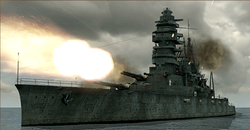 | |
| Armaments | AA Weapons: 76mm AA guns x8 Artillery: 14 in guns x8, 6 in guns x16 |
|---|---|
| Class | BB |
| Speed | 30 knots |
| Strong against | Ships |
| Weak against | Other battleships, submarines, aircraft |
Technically a battlecruiser, the Kongō-class therefore does not pack the punch of larger battleships such as the Yamato-class or Iowa-class. However, it also costs significantly less in unit points than both those classes, meaning numbers make up for less firepower.
The Kongō is a semi-reliable battleship that can cause critical damage to smaller enemy ships before going under, particularly other cruisers. It is essentially a Fusō-class, but without the two centre turrets, making the Kongō the weakest Japanese battleship in the game. Despite this, it can seriously outrange lesser ships, particularly heavy cruisers, giving it a huge advantage. Its armour, while not considerable when compared to battleships, is very thick compared to cruisers and virtually invincible to destroyers. As with all battleships, however, it is extremely vulnerable to torpedoes.
Official Description: Designed by Britain's Sir George Thurston, and entering service during the First World War, these were the first modern battlecruisers in the Imperial Navy. They are well armed, with large main and secondary batteries, and have recently received upgrades to their armour and engines. However, they are still not a match for modern battleships, though smaller surface ships have much to fear from them.
Fusō-class
With 12 guns arranged into six double-barrelled turrets, other ships will have extreme difficulty in disabling the Fusō's artillery. It has, by far, the most number of turrets in the game - this means that even with one or two turrets destroyed, the Fusō still has most of its attacking power.
Due to the large number of guns it carries, it serves very well as a coastal bombardment role, and can neutralize an enemy headquarters quickly with cannonade. Its air defences, while present, are not sufficient enough to have the Fusō be able to act on its own if there is a threat of an aerial attack. In this event, it should be kept under constant protection, especially against air and submarine attack.
The Fusō has a relatively slow speed, necessitating its defence, particularly against torpedoes. While most aircraft will have problems causing damage due to Fusō's heavy deck armour, several planes can disable - or at least critically damage - Fusōs enough to allow other ships to deal the finishing blow. Carpet bombers like the B-17 have had a sharp increase in effectiveness against battleships.
Official Description: "Fusō" is an archaic name for Japan, and these venerable battleships were the first IJN vessels to be built completely with Japanese technology and armament. Laid down in 1912, they are somewhat outdated now but have been modified with improved armour and engines. They are very well armed, carrying twelve 14" guns alongside a very large battery of secondary 5" guns in casemates along either side, making them a powerful adversary for any opponent. However, despite modernization, their armour is still relatively thin, making engaging other battleships a risky proposition. Their AA armament is also quite light, leaving them vulnerable to air attacks.
Yamato-class
The Yamato-class is the most powerful ship class in the game, with incredibly thick armour and the largest diameter guns ever put on a ship. This makes it a formidable force on the battlefield, sporting three turrets as its main armament, each containing an 18.1" gun. Its anti air capabilities are also fairly strong, with several dual purpose and armoured 25mm AA guns. However, as is the case with all ships, it is vulnerable when singled out on its own. Tiny Tim rockets, carpet bombers, and torpedo bombers can damage this ship before it can close in to cannon range. When compared to Iowa, Iowa seems to possess better AA guns than the Yamato-class, which goes some way to compensate for its weaker structure and less powerful guns.
The Yamato is especially vulnerable against enemy submarines, although it does possess the ability to launch a single floatplane equipped with depth charges to help combat this threat. This helps a little bit, but it is recommended to have destroyer escort to spot submarines further out. Due to the high unit price in island capture (300 pts), it is an expensive investment. That said, a concentrated and sustained attack from multiple opponents can put this battleship under, as can submarines and massed aircraft.
The Yamato is an unlockable unit, and can be unlocked by completing Mission 7 - Invasion of Midway with a gold medal.
Official Description: The Yamato is, quite simply, the biggest, best armoured and most powerfully armed ship ever built. Weighing almost twice as much as any other battleship afloat (with the exception of her sister ship the Musashi), she is the pride of the Imperial Fleet. Her 18.1" main guns can smash through the armour of any opponent, and will destroy smaller ships with a single shot, while the huge secondary batteries she carries give her excellent defence against air attack. Only a sustained and concerted attack by a much larger force has any chance at all of successfully engaging this titan. The Yamato is currently the flagship of Admiral Isoroku Yamamoto, Commander of the Combined Fleet.
Shōhō-class
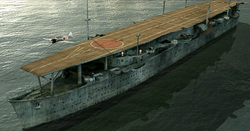 | |
| Armaments | AA Weapons: 25mm AA guns x4 Artillery: 5 in guns x2 |
|---|---|
| Class | CVE |
| Speed | 28 knots |
| Strong against | Nothing |
| Weak against | Ships, submarines, aircraft |
Although the Shōhō-class is not a playable unit at all during the game, it plays a critical role in Mission 4 - Saving the Shōhō, so it is good to know how it performs. As a light carrier unit, it lacks the armament and hangar capacity of the larger Japanese carriers, and as such relies heavily on its escorts to provide AA, artillery and anti-submarine cover for it. In the game it features just 4 25mm AA guns and 2 5 in artillery guns, making it an easy target for enemy attacks. As such, CAP cover is a big help during the mission.
Both dive bombers and torpedo bombers can easily damage the ship, and just a few hits can spell the end for it. It carries Zero fighters, or, if equipped, J7W Shindens, both of which prove useful in defending the carrier against enemy air attack. Furthermore, it is especially vulnerable against enemy submarines.
Official Description: Originally designed with the adaptability to be completed as a high-speed oiler, submarine tender or a smaller aircraft carrier. The Shōhō, along with her sister ship, the Zuihō were both completed as aircraft carriers, and they immediately joined the Combined Fleet. Armed with only a few guns and minor anti-air armament, they rely on their air wings and escorts as defense. Not completely designed as frontline warships, they are vulnerable and could be easily taken out by air or naval power.
Hiryū
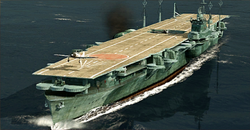 | |
| Armaments | AA Weapons: 5 in .50 caliber dual purpose guns x6, 25mm AA guns x6 Artillery: 5 in .50 caliber dual purpose guns x6 |
|---|---|
| Class | CV |
| Speed | 20 knots |
| Strong against | Aircraft |
| Weak against | Ships, submarines |
The Hiryū is a large carrier vessel which features heavily throughout the campaign and in online play. As with all Japanese carriers playable in-game, it features an impressive array of AA weapons, including six 5 in DP guns on top of the standard 25mm AA guns.
Whilst not as vulnerable as some vessels, as a carrier it can easily be damaged by most attacks, and as such a good escort is advised. Thanks to its dual purpose guns, it is able to hold off mild air attacks. However, its own AA defences are not sufficient to withstand more dedicated attacks.
Official Description: The Sōryū and her sister ship the Hiryū were commissioned by the IJN in 1937; the first large carriers to join the Imperial Fleet since Akagi and Kaga were commissioned in the late '20s. The two Sōryū Class ships are commanded by Vice-Admiral Chuichi Nagumo. As with all Japanese fleet carriers, they have a large number of fighter and strike aircraft aboard.
Sōryū
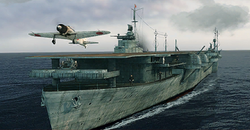 | |
| Armaments | AA Weapons: 5 in .50 caliber dual purpose guns x6, 25mm AA guns x6 Artillery: 5 in .50 caliber dual purpose guns x6 |
|---|---|
| Class | CV |
| Speed | 20 knots |
| Strong against | Aircraft |
| Weak against | Ships, submarines |
The Sōryū is the Hiryū's sister carrier, and as such it shares its armament and general specifications with the Hiryū. Unlike the Hiryū, however, it is a non-playable unit and rarely features during the game. As with Hiryū, it is a full size carrier vessel.
Official Description: The Sōryū and her sister ship the Hiryū were commissioned by the IJN in 1937; the first large carriers to join the Imperial Fleet since Akagi and Kaga were commissioned in the late '20s. The two Sōryū Class ships are commanded by Vice-Admiral Chuichi Nagumo. As with all Japanese fleet carriers, they have a large number of fighter and strike aircraft aboard.
Akagi
| File:BSP Akagi.PNG | |
| Armaments | AA Weapons: 5 in .50 caliber dual purpose guns x6, 25mm AA guns x6 Artillery: 5 in .50 caliber dual purpose guns x6 |
|---|---|
| Class | CV |
| Speed | 20 knots |
| Strong against | Aircraft |
| Weak against | Ships, submarines |
As with the Hiryū, the Akagi is a full size carrier vessel and features excellent AA capability for a carrier, with six 5 in dual purpose guns and six 25mm AA guns. Whilst these dual purpose guns do not pack the punch of larger diameter artillery, they are useful for taking out small threats in emergency situations, and can be lifesavers against air attack.
It is advisable you always maintain a heavy escort - as with all carriers the Akagi is incredibly vulnerable to most forms of attack, especially involving submarines, destroyers or heavier ships.
Official Description: The Akagi and the Kaga were the first large carriers to join the Imperial Fleet, and have had long and distinguished careers. Originally built as battlecruisers, they were remodelled as carriers in the aftermath of the Treaty of Washington, which explains their unusual appearance. The Akagi is currently the flagship of Vice-Admiral Nagumo's Carrier Striking Force.
Kaga
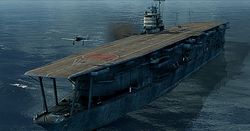 | |
| Armaments | AA Weapons: 5 in .50 caliber dual purpose guns x4, 25mm AA guns x6 Artillery: 5 in .50 caliber dual purpose guns x4 |
|---|---|
| Class | CV |
| Speed | 20 knots |
| Strong against | Aircraft |
| Weak against | Ships, submarines |
The Kaga has a slight firepower disadvantage when compared to the Akagi, with two less 5 in DP guns. However, you will rarely find a situation where this directly affects the survivability of your ship, so it makes little difference. Otherwise, the Kaga and Akagi are very similar, both carrying a multitude of strike and fighter aircraft.
The 25 mm AA and 5" DP guns will stand up to a small air threat, but as with all carriers, an escort is highly advised. A single torpedo hit or aerial bomb can have devastating effects, and even a small scale attack has the capability of sinking this vulnerable unit. The Kaga is also especially vulnerable to submarine attack, so a scout unit equipped with sonar to patrol is a good idea.
Official Description: The Akagi and the Kaga were the first large carriers to join the Imperial Fleet, and have had long and distinguished careers. Originally built as battlecruisers, they were remodelled as carriers in the aftermath of the Treaty of Washington, which explains their unusual appearance. The Akagi is currently the flagship of Vice-Admiral Nagumo's Carrier Striking Force.
Type A
 | |
| Armaments | Torpedoes: Torpedo tubes x2 (8 torpedoes) |
|---|---|
| Class | SS |
| Speed | 40 knots |
| Strong against | Cargo ships, destroyers, submarines |
| Weak against | Cruisers, PT boats, aircraft |
The Type A is a unique unit when compared to other submarines featured in that it is a midget submarine. Whilst it is only playable in Mission 10 - Attack on Sydney Harbour, it is useful to understand its strengths and weaknesses. As a midget submarine, it lacks the endurance or armament of larger subs; it has no AA or artillery capabilities whatsoever, and features just two torpedo tubes carrying 8 torpedoes in total. Its small size also means you will have to surface regularly to refill your oxygen supplies. Despite all its shortcomings, the Type A is an adequate unit for the mission it appears in.
Due to its small size, the Type A handles exceptionally and is incredibly fast, capable of reaching 40 knots when surfaced, and 33 knots at depth. As a result of this agility, some players have given them the nickname of "fighter subs". This agility lets it easily out-manuveur depth charge attacks and mines. However, unlike its larger relatives, it is incredibly fragile and a few good hits will send it to the sea bed, so watch out for this when controlling the unit.
Also as a result for its small size and unprecedented manoeuvrability (for a submarine), a theoretical confrontation between a fleet submarine and a Type A would favour the Type A.
Official Description: The Type 'A' Target Midget Submarine is a top-secret Japanese weapon. Codenamed the 'Ko-hyoteki' and built in 1938, its small size allows it to creep into enemy harbors to attack ships at anchor. This is something that would be difficult or impossible for a normal-sized submarine thanks to the shallow waters of most harbors. Armed with two torpedoes, and manned by a crew of two, this craft is potentially devastating in its dedicated role but virtually useless for any other kind of task.
Type B
The Type B is the basic full size Japanese submarine, and generally is adequate in most areas. It is fairly quick - when surfaced it is capable of 33 knots, and this slows to roughly 28 knots when submerged. In terms of armament, the Type B has six forward facing torpedo tubes, capable of launching in total 48 torpedoes, however you will very rarely need to use all of these. Its main weakness is its blind rear spot - unlike the US submarines, the Type B has no rear firing torpedo tubes, meaning destroyers approaching from behind are your main enemy here.
When surfaced, the Type B has the ability to launch a single Jake seaplane carrying a cargo of 2 bombs. This can act as a scout or a light offensive unit, and can be invaluable in a game situation. Its surface weaponry is fairly light - a single 5 inch, 50 caliber artillery gun can cause damage to anything lighter than a cruiser, and, in many situations, when playing the games AI a Type B has the potential to annihilate even a destroyer provided you avoid the ships broadsides. Its single 25 mm AA gun is no use at all, providing little or no cover from air strikes, so when surfaced ensure you use other units to intercept air threats. Unlike the Type A, the Type B can stay at the deepest dive level for much longer before sustaining damage, making this level useful for emergency situations.
Official Description: The Type B is the most numerous and modern submarine design in service with the IJN. Only coming into service in 1940, these are fast, long-ranged ships, and every bit the match for the U.S. Narwhal-class subs. Like all submarines, they are very vulnerable when on the surface, thanks to their lack of armour and firepower - but submerged, they are a danger to any ship.
Sen Toku I-400 class
Possibly the best Japanese submarine featured, the I-400 was the largest sub built during WWII, and this shows in its manoevrability. Turning requires thinking ahead, as the I-400 is sluggish to respond and turns at a slower rate than most other submarines, however it is fairly quick in a straight line, capable of 33 knots when surfaced, and 28 when submerged. Another plus to the I-400 is its hangar, capable of carrying three M6A Seiran recon planes equipped with a single bomb each. This addition maximises the I-400s strike potential, and means it has some protection from destroyers or aerial threats, however it is unwise to rely on this solely.
Its carrying capacity of 64 torpedoes is huge in comparison to the Type B, meaning you can strike many more ships and can afford to spread numerous torpedoes to guarantee hits. As with the Type B, however, the I-400 has no rear facing torpedo tubes, meaning this blind spot can be capitalised upon by enemy destroyers equipped with depth charges. On the surface, the I-400 has a much more impression arsenal, sporting three 25mm AA guns and a single 5 inch gun. Whilst these mean the I-400 actually has anti-air potential, it is still highly advised you have air support of some kind. In addition, the sub features a single 5.5 inch gun which can easily take care of light ships if necessary. The I-400 also has exceptional endurance at the lowest depth level - its hull takes a long time to deteriorate to danger levels, allowing you to use this depth level much more if you see fit.
The I-400 is an unlockable unit, and can be unlocked by completing Mission 6 - Hunt for the USS Hornet with a silver medal.
Official Description: The I-400 Class submarines, also called 'Sen Toku' were the largest submarines ever built in World War II, and also the largest submarines built before the huge nuclear ballistics submarines of the cold war. Capable of going around the world one and a half times. The boat has eight torpedo tubes mounted forward, a large deck gun and a number of 25mm guns for anti-air defense. The I-400 also carries three M6A Serian airplanes in a large, cylindrical hangar built in the boat. The Seirans can carry a torpedo or bombs up to 800kg and have a great speed and long range, extending the offensive capabilities of the I-400.
Kaiten Carrier
The Kaiten carrier is a modified Type B, so it shares much of its armament and respective performance with the class. Its main difference is its capability to carry six Kaiten manned torpedoes, devastating suicide weapons which can be used to your advantage with dramatic results. Due to the fact that these are mounted on the exterior of the submarine, the sub loses nothing over the Type B other than its capability to launch a seaplane. This can be a disadvantage in some cases, reducing your air cover, so a fighter scout group is a good idea. Like the Type B, the Kaiten carrier features 6 torpedo tubes carrying 48 torpedoes in total, and a single 5.5 inch artillery gun. The sole 25mm AA gun is of little use, and has a very narrow firing window.
The Kaitens themselves allow you to launch accurate attacks from much further distances than with a conventional submarine, so make sure you include this in your strategy for better results. It also means destroyers can be taken out from a much farther distance, reducing the chance of their depth charges coming to bear on you. Kaitens can also only be launched when submerged.
The Kaiten carrier is an unlockable unit, and can be unlocked by completing Mission 10 - Attack on Sydney Harbour with a silver medal.
Official Description: The Japanese navy decided to install Kaiten suicide torpedoes on many different naval vessels. This Type B submarine is also equipped with the deadly Kaitens. All Kaitens carry a huge explosive warhead, and can be launched even when their mother submarine is submerged. With this addition this submarine is the most powerful and destructive underwater force ever seen in the Pacific theater.
Kaiten
 | |
| Armaments | None (Kamikaze) |
|---|---|
| Speed | 53 knots |
| Strong against | Ships |
| Weak against | Artillery fire, aircraft |
The Kaiten is a manned suicide torpedo, introduced late in the war in desperation. It is launched from the Type B Kaiten Carrier in game, and is fully controllable right to its target. Although it is the fastest unit on the game at 53 knots, compared to conventional torpedoes it is deadly slow, making it an easy target for surface artillery or AA fire. Its weak hull means that it can be easily taken out by moderate artillery capabilities, however, firing a spread of Kaitens will ensure devastating results. The Kaitens themselves can only be launched when submerged and are incredibly agile, able to turn much faster than any other unit on the game.
Whilst a single Kaiten may not do much damage, firing them in large volumes will ensure the sinking of even the most hardy ships, and their manoeverability means they can be accurately fired from much longer distances. Their limited fuel and oxygen supplies mean the unit will last for roughly 2 minutes before 'sinking', but this is more than enough time to reach most targets.
As of this writing, Kaitens are bugged and will cause very little - if any - damage to targets. Ohkas and kamikaze aircraft cause remarkably more damage than Kaitens, and it is likely a patch will bring Kaitens up to standard.
Official Description: The Kaiten manned human suicide torpedo is a Long Lance torpedo modified to house a single pilot. Once inside the Kaiten, the pilot is locked in from the outside and cannot get out. Kaitens are carrying a 3000 lb (1600 kg) explosive charge in their bow. With limited fuel capacity and slow speed, they can only make a few attack runs on their targets until the fuel runs out. They are extremely vulnerable, and even a near miss from a large caliber gun can fatally damage them. They are carried to the battlefield by modified Type B submarines.
Troop Transport
The Japanese and US troop transports are basically identical, except slight armament differences, but both can prove to be invaluable in island capture multiplayer matches. The Japanese troop transport is equipped with a single 4.7 in .45 caliber DP gun which provides its only artillery, and this in conjunction with four AA guns provides basic air cover. At no stage should the troop transport be left unguarded, as it is vulnerable to all forms of attack, no matter how crude. Its weak hull can be destroyed with just a few good artillery hits. Its own artillery should only really be used on unarmed ships, and its AA defences can effectively deal with only one squadron at a time.
When in the capture range, it launches eight Daihatsu barges which then approach the shore to capture the island. Daihatsus will continuously capture the island until they are destroyed (at which the landing ship will spawn a new one) or the island is captured. Paratroopers, on the other hand, provide a one-time boost to the capture rate.
Official Description: Both the US and Imperial Navies co-opted a large number of civilian cruise ships for the purpose of transporting soldiers long distances. When close to a landing zone, the troops then disembark using landing craft such as Higgins Boats or Daihatsu barges to reach the shore. As these are civilian ships, they are not armoured in any way, which makes them easy targets. However, they are usually fitted with some light armament to give them a chance against attackers, and enables them to support landing operations.
Type SB Landing Boat
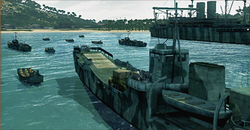 | |
| Armaments | AA Weapons: 13mm AA guns x3 Artillery: 5 in gun x2 |
|---|---|
| Class | LST |
| Speed | 38 knots |
| Strong against | Nothing |
| Weak against | Warships, aircraft, submarines |
The Type SB Landing Boat has pretty much the same purpose as the troop transport, except it is more heavily armoured and quicker. While its artillery remains virtually unchanged (its two artillery guns have firing arcs to port and starboard), it is faster and significantly smaller, making it tougher to hit.
Another difference between the troop transport and the Type SB is the landing procedure itself. The Type SB becomes uncontrollable once it reaches a certain proximity to the island it's ordered to capture. It eventually beaches itself on the island, unloads its cargo, and then disappears. Essentially, it is a larger, slower, playable version of the Daihatsu LCP.
Its disappearing act once the island is captured is not necessarily a negative trait. Aside from a lower cost, the LST's disappearance frees up the command points invested in it. This makes the LST effective in capturing islands in the outskirts of the map, as once the capture is done, another unit can be spawned immediately.
The artillery power of the Type SB is adequate for its duties, but at no point should you attempt to take on a warship with it. Even a destroyer heavily outguns it, so instead keep it well away from the field of combat. Its AA defences consist of three 13mm machine guns, and these have nowhere near the potential to take out incoming threats, so air cover or a convoy is a good idea.
Official Description: The Japanese military have never been shy to copy good ideas from elsewhere, and the SB Boat is a prize example of this. Observing the efficacy of the American LSTs at landing heavy materiel in amphibious assaults, the IJN rushed into production their own design with laterally-opening bow doors. The SB mounts twin 5" guns on forward pivots, along with machine guns for defense, but it is far from being a combat vessel.
Daihatsu LCP
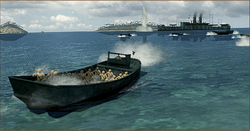 | |
| Armaments | AA Weapons: 7.7mm machine gun x1 |
|---|---|
| Class | LCP |
| Speed | 25 knots |
| Strong against | Nothing |
| Weak against | Warships, aircraft, submarines |
As the Japanese equivalent of the Higgins boat, the Daihatsu LCP is lightly armoured and carries just one 7.7mm machine gun for defense, making it an easy target all round. Due to this fact, they are usually launched in volume, and enemy AI will have difficulty totally destroying your landing effort, however, a few good hits from AA guns or an aircrafts machine guns will send this boat to the sea bed, so watch out. As with the Higgins boat, the Daihatsu is not a controllable unit, but can be launched from troop transport ships to capture islands.
Due to its light structure, the Daihatsu sits high in the water and as such torpedoes are useless against them, however surfacing and using a submarines AA capability can finish it off quickly. The machine gun mounted on the Daihatsu is only ever a threat when strafing at a slow speed, and even then your aircraft is only in danger if there are several of the units in close proximity, being able to concentrate their fire. Using artillery to take out these boats is possible, however due to their small size, it is much easier to use AA weaponry.
Official Description: These small flat-bottomed barges are similar in function to the Higgins boats used by the US Marine Corps, and are used by the Japanese in amphibious assaults to land troops on enemy held shores. They are light, fragile craft, and are easily destroyed; however, their small size means that they are best targeted with machine gun fire. They carry a single machine gun themselves, giving them only very rudimentary defense.
Shinyo
 | |
| Armaments | None (Kamikaze) |
|---|---|
| Class | N/A |
| Speed | 30 knots |
| Strong against | Ships |
| Weak against | Artillery & AA fire, aircraft, submarines |
The Shinyo, like the Kaiten, was a manned suicide weapon, this time in the form of a small, high speed motorboat. These units are not controllable, and are only encountered twice during the whole game, in the American Mission 13 - Invading Iwo Jima, and again (but not in large numbers) in the last American mission. The unit itself is crude, and destroying it is notably similar to destroying an LCP. As the smallest sea unit in game, the Shinyo can be difficult to hit accurately, but is best tackled from the air.
Due to the fact they carry no defensive measures, a single fighter squadron can take out almost unlimited numbers of these boats whilst taking no damage itself. Their weak structure means that any which venture anywhere near your landing ships are easily taken out by AA and artillery fire, however if one hits it can do severe damage, and it takes only a few to cripple a ship entirely.
Official Description: The Shinyo motorboats, also called 'Sea Quake' are Japanese suicide boats. They are part of the wider Special Attack Units program. They are typically equipped with two depth charges as explosives in the bow. They lack any armament, or armor, and they can be easily destroyed, their only protection is speed, relatively small size and maneuverability.
